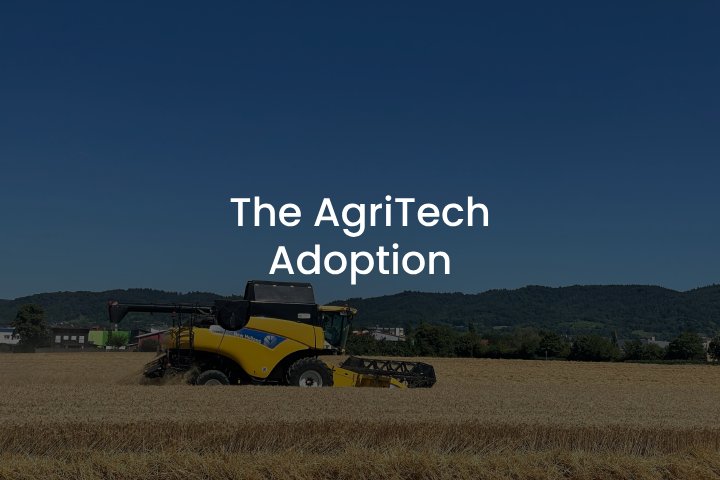
The AgriTech Adoption: Challenges and Opportunities for the Future of Farming
Agricultural technology, or AgriTech for short, is the use of modern technology with regard to farming and related activities. Future agriculture may be completely transformed by AgriTech.
Agritech has the ability to enable farmers to maximize resource utilization, improve agricultural yields while cutting costs, and make decisions based on facts. Robotics, GPS, and remote sensing technologies provide the best possible implementation of the planting, watering, fertilizing, and harvesting operations. In the meanwhile, soil and agricultural data can be examined by machine learning and artificial intelligence to forecast outcomes, spot diseases, and increase crop yield.
The next agricultural revolution may be sparked by this technology. Widespread AgriTech adoption is still beset by some issues, however. The high expenses, technological complexity, and inadequate infrastructure might cause farmers to embrace advances slowly. Overcoming these challenges, however, may mean a promising future for AgriTech farming.
Benefits of Adopting AgriTech
Agricultural technology offers many benefits to farmers and the agricultural industry in general. Using AgriTech solutions offers the following main benefits:
Growing Production
Farmer crop yields are one of AgriTech’s main advantages. Precision agricultural equipment like sensors, GPS, satellite photos, and sophisticated data analytics let farmers make the most of their resources and inputs. They are better able to concentrate on crop treatments and irrigation, using them only where they are needed and reducing waste. As a result, output per acre or hectare can improve substantially. Agritech enables higher crop quality and health as well.
Optimization of Operations
Agritech gives data-driven insights to streamline agricultural operations. Monitoring sensors can track soil conditions, crop growth, and livestock vitals in real time. Analytics dashboards give farmers actionable recommendations to enhance productivity. Automation technology can take care of routine tasks like irrigation, freeing up farmers’ time. Overall, AgriTech allows for smarter decision making and more efficient resource allocation on the farm.
Sustainability
Sustainability is a key advantage of AgriTech adoption. Precision tools reduce unnecessary fertilizer, pesticide, and water usage, preventing pollution and runoff. GPS-enabled equipment cuts down on fuel consumption. Sensors monitor soil health to prevent over-farming and depletion. Robotics and automation reduce food waste. Agritech enables farmers to maximize yields while implementing more sustainable practices. This benefits both economic and environmental goals.
Challenges Facing AgriTech Adoption
The adoption of agricultural technology (AgriTech) faces several key challenges that have slowed its uptake among farmers. While AgriTech promises increased efficiency, productivity, and sustainability, barriers exist that prevent many farmers from integrating these advanced tools and techniques. The main challenges include:
Upfront Costs
Implementing AgriTech becomes difficult due to the high upfront expenses of buying and placing new technology into use. For many farm enterprises, the capital expenditures required for advanced equipment like GPS-enabled tractors, drones, moisture sensors, and variable-rate irrigation systems are prohibitive. Further raising the cost are data management systems, technical support, and networking infrastructure. Even in cases when long-term advantages are clear, the financial costs could be too high for small to medium-sized farms. Creative financing options could help alleviate this adoption barrier.
Learning Curve
Another major pain point is the steep learning curve associated with AgriTech systems. While the tech may be cutting-edge, many farmers are not prepared or properly trained to fully utilize complex data analytics, precision agriculture techniques, or advanced mechanization. To successfully adopt AgriTech tools, farmers must invest substantial time and effort into learning entirely new processes. Younger, college-educated farmers may have an advantage here. Additionally, clear user-friendly designs and sufficient vendor training programs are needed to smooth the transition process for farms of all sizes and skill levels.
Connectivity Issues
In rural agricultural areas, limited or unstable internet and cellular connectivity is a recurring obstacle to the adoption of AgriTech. Real-time data transfer from the field is essential to precision farming in order to operate automated machinery and guide managerial choices. However spotty coverage continues to disrupt these information flows on many farms. Investments in rural broadband infrastructure are critical to enable cutting-edge technologies to function as intended. Similarly, gaps in electricity access on remote farms can make powering and charging tech tools difficult. Overcoming connectivity and power challenges will be key to unlocking the full benefits of data-driven, networked ag technologies across the farming landscape.
The Future of Farming with Agritech
Agritech promises to transform agriculture in exciting ways in the coming years and decades. Here are some predictions on where AgriTech adoption could take the industry:
- Ultra-precision farming: With sensors, data analytics, AI, and automation, farms will have unprecedented abilities to monitor crop health, tailor inputs, and treatments down to the individual plant level, and automate routine tasks. This could lead to major gains in productivity and sustainability.
- Indoor vertical farming: Growing produce and other crops in indoor urban vertical farms using hydroponics, LED lighting, and climate control could become widespread. This allows food production right in cities, reduces water usage, and eliminates concerns over seasons, weather, and pests.
- Robotics and automation: More farming tasks, especially repetitive and dangerous jobs, will become automated using robotics, AI, and drones. This includes harvesting, weeding, monitoring, and data collection. Human labor requirements could drop dramatically.
- Alternative proteins: Using biotech, fermentation, and precision techniques, more meat and other proteins will be produced through non-animal means in labs or factories. This could disrupt livestock industries.
- Traceability and transparency: Blockchain, IoT sensors, and genetics tracking will make the origins and journey of food highly traceable. Consumers will demand transparency.
- Climate resilience: Agritech will help farmers adapt to climate change through drought-resistant seeds, climate-adaptive techniques, and data-driven weather prediction and planning. Agriculture will become less climate-vulnerable.
- Farmer empowerment: With AgriTech lowering barriers and costs, more smallholder farmers and groups in developing nations can access information, financing, markets, and innovative techniques. This spreads economic opportunity.
Agritech has huge potential, but only if challenges like access, education, and adoption are addressed. If embraced, AgriTech can feed the world and revolutionize farming.
To Sum Up
The adoption of AgriTech is difficult but also very promising for farming in the future. Together, farmers, agribusinesses, investors, and legislators can promote the broad use of AgriTech and maximize its advantages. Successful use of AgriTech breakthroughs will determine the future of sustainable farming.


